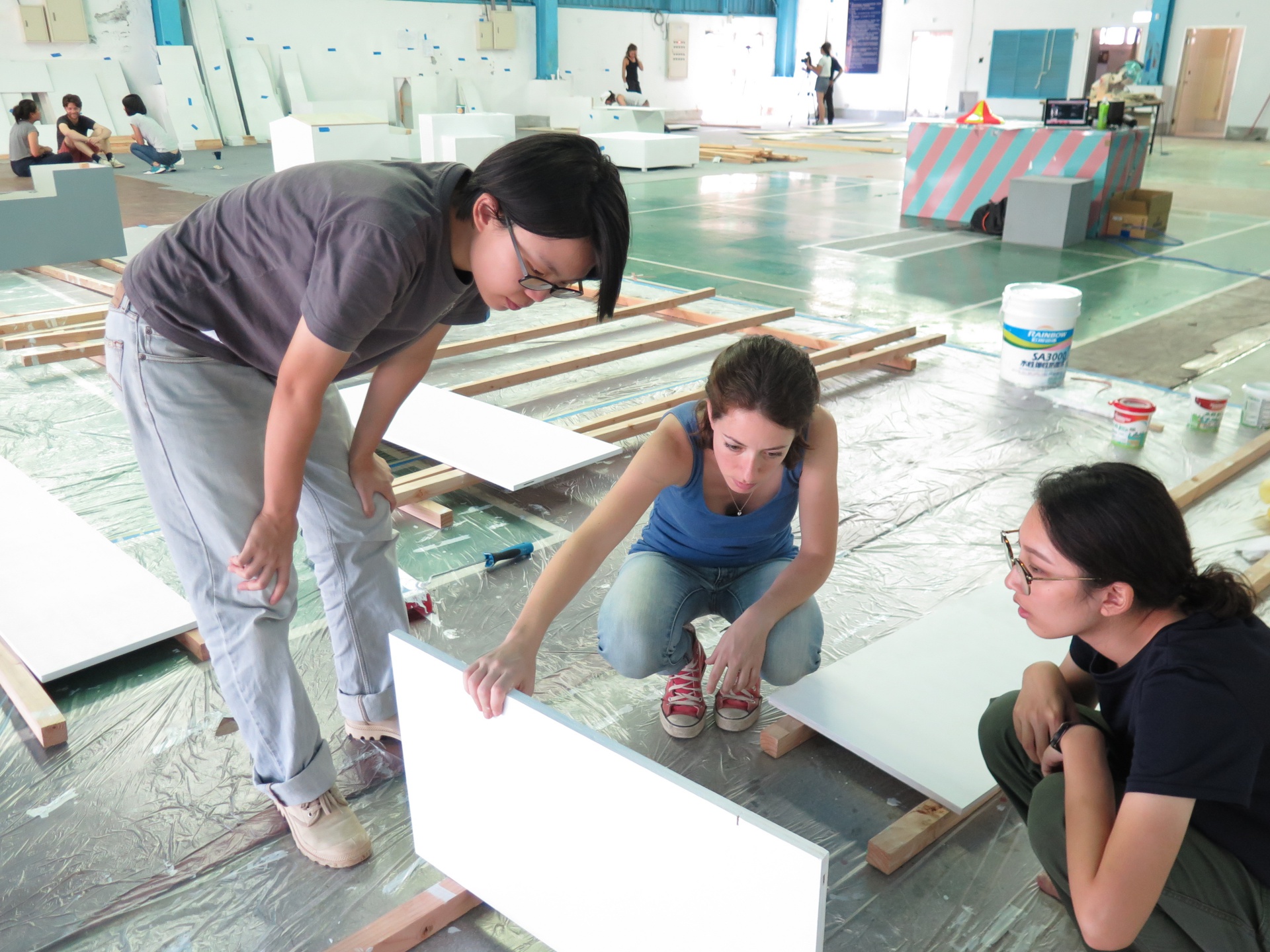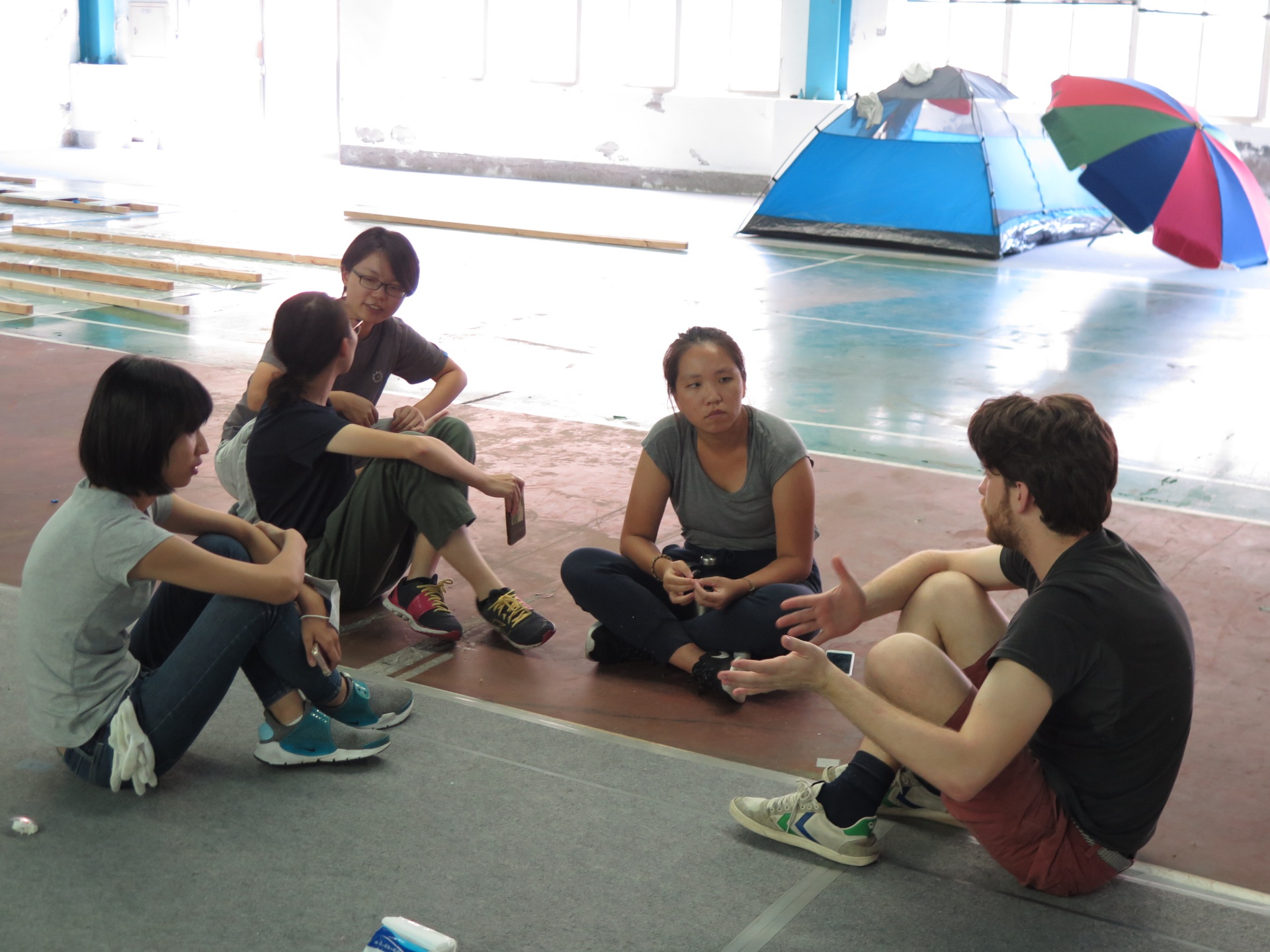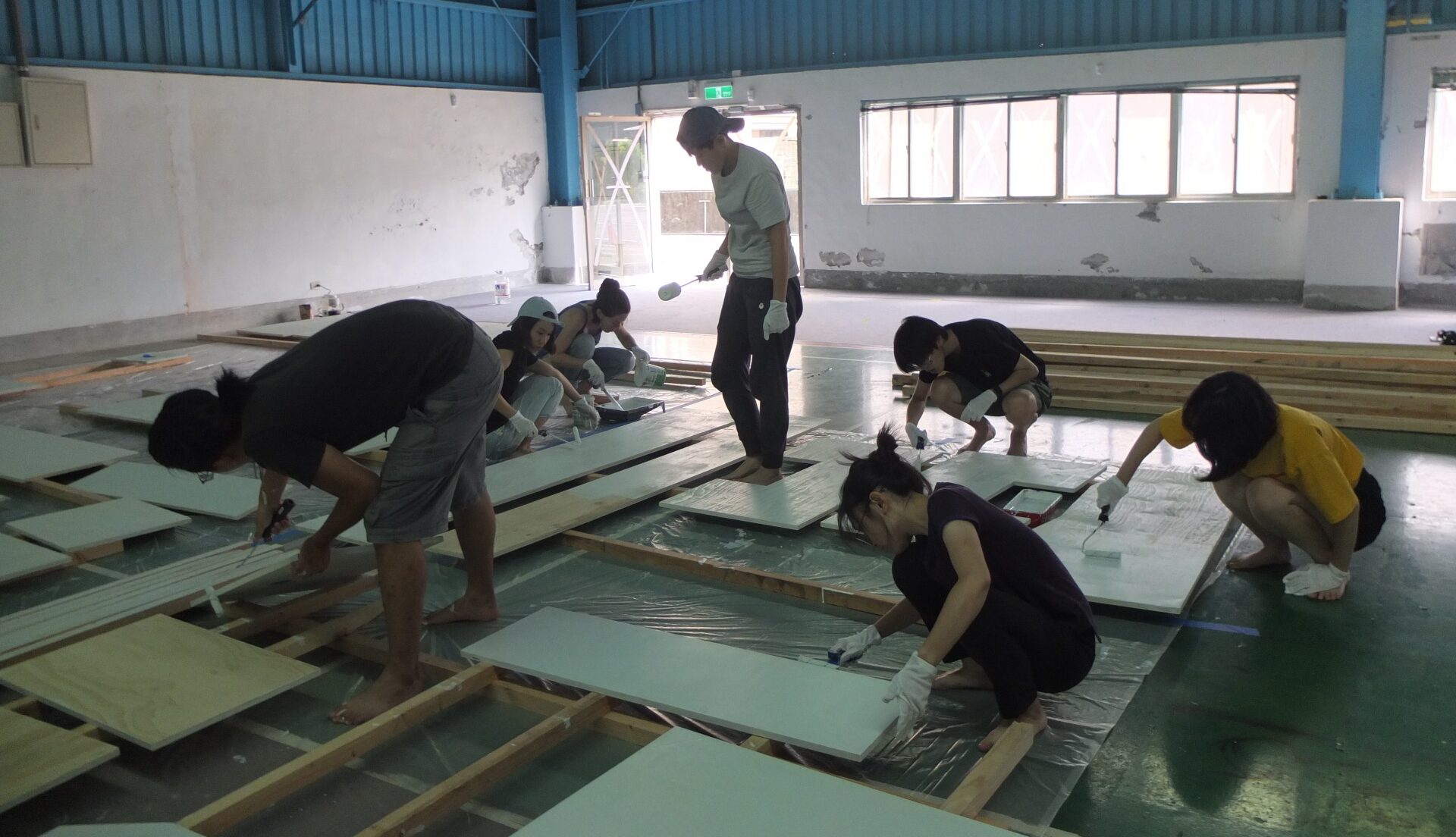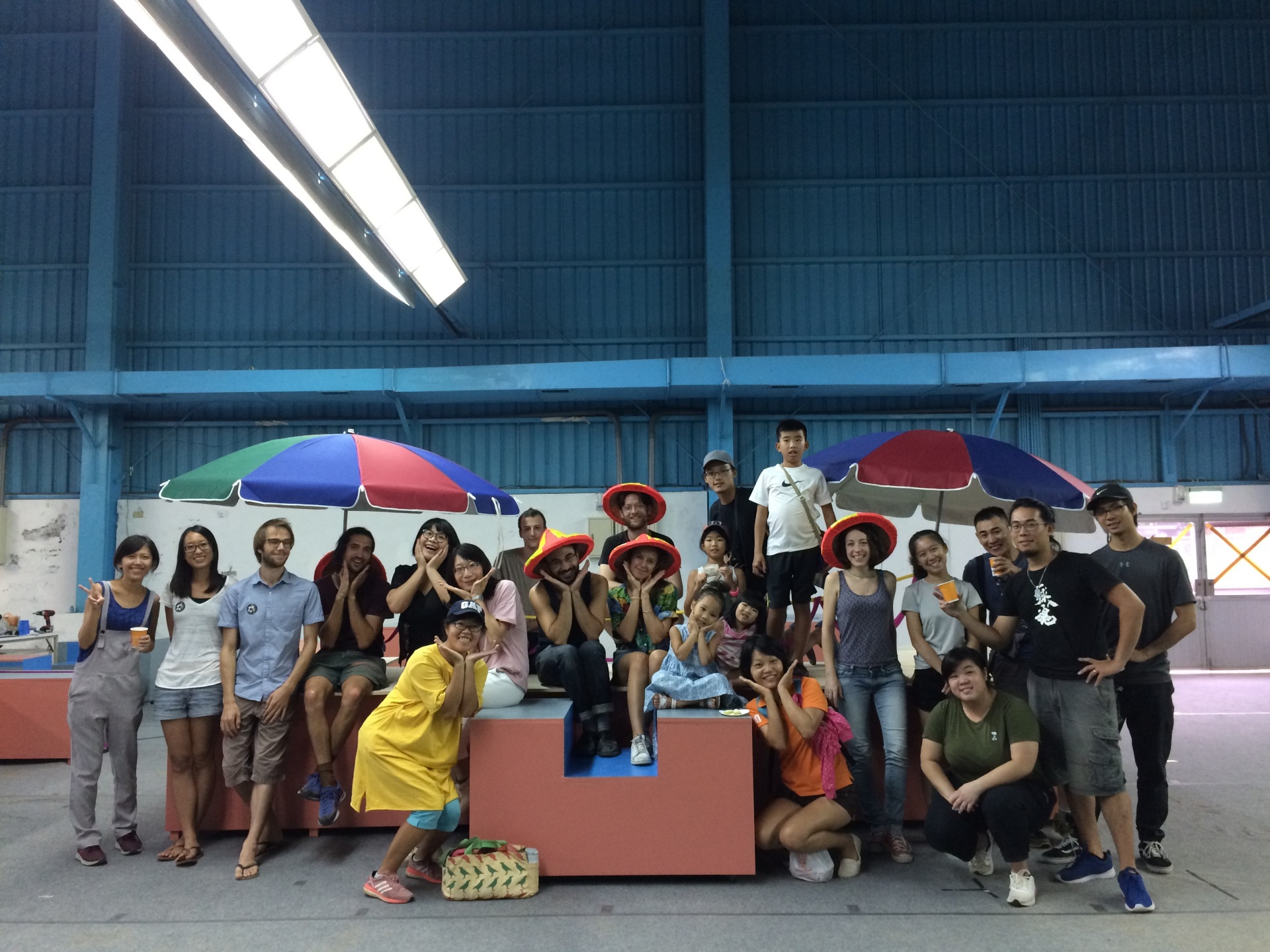偌大的羽球館空蕩蕩的,只有幾張放滿工具的桌子。短短十天之內,這裡搖身一變成為緊鑼密鼓的工作場所,由進駐臺灣當代文化實驗場(C-LAB)的法國團隊帶領志工們,從剛運送來的木料開始,親手創造許多大型戶外移動式家具。成品的外型仿造C-LAB的建築外觀,擺放在一起,儼然成為整個園區的縮影。這層「再現」不僅引導使用者認識C-LAB的建築特色,充滿趣味與可移動的細節設計,也讓這些家具的未來有更多自由使用的彈性組合。
這個點子來自於Yes We Camp(簡稱YWC),一個主要駐點於法國巴黎和馬賽,由對翻轉城市空間有熱忱之青年組成的社會創新團體。早在2018年6月,他們就來到臺灣進行參訪,在以臺北為根據地的法國城市規劃團體Urban Tai-ouan協助下,除了熟悉C-LAB與周邊環境,也拜會了以城市規劃、藝術和建築等不同專業的工作團體,相互討論與交流學習。而後,YWC針對園區的客觀條件觀察分析,發想了四種創新改造提案,經由C-LAB內部需求討論並從中選定一項,兩方再合力將之實現。
其實每個創新提案的大方向都是類似的:希望能夠將這塊過去是空軍總司令部的園區面向社會大眾開放,改變過往的封閉與權威性,成為在地居民、觀光客,或者文化藝術工作者皆能享受的公共空間。因此,YWC四個改造提案目標都關乎提高市民參與,促進公眾對此地的再認識,將人文活力注入這個場域,更重要的是,藉由創新思維翻轉空間的使用方式與想像。
 進駐C-LAB的法國團隊帶領志工們,從剛運送來的木料開始,親手創造許多大型戶外移動式家具。圖/臺灣當代文化實驗場提供
進駐C-LAB的法國團隊帶領志工們,從剛運送來的木料開始,親手創造許多大型戶外移動式家具。圖/臺灣當代文化實驗場提供
 YWC將活動聚焦於「開放工作室」的形式,向外徵求對家具實作有興趣的志工,協助他們一同完成任務。圖/臺灣當代文化實驗場提供
YWC將活動聚焦於「開放工作室」的形式,向外徵求對家具實作有興趣的志工,協助他們一同完成任務。圖/臺灣當代文化實驗場提供
選定製作戶外移動式家具的提案後,由於時間與空間的限制,YWC決定將活動聚焦於「開放工作室」的形式,向外徵求對家具實作有興趣的志工,協助他們一同完成任務。於是年齡不一的學生和上班族帶著不同的理由,齊聚於此,有人懷著對木頭敲敲打打的嚮往,也有人純粹覺得和來自國外的團體一起工作會很有趣,更有曾為工業設計系、現為家庭主婦的媽媽呼朋引伴而來。雖然這群夥伴不一定都有木工經驗,但想透過實作,親手創造一些事物的心情卻是相通的。
實際上,這些工作拆開來看並不困難,只是需要大夥齊心協力合作,才可能在有限的時間內完成。最基本的步驟如下:首先依照設計圖,在木料上量出每塊木板所需的形狀和尺寸,由專業人員使用機器切割並組裝,一間一間房屋般的家具便大致成形;後續接著在縫隙與凹洞間添上補土,將表面打磨光滑、漆上底漆與仿造C-LAB建物的外漆色彩搭配,待顏料風乾後即大功告成。
 每天皆有不同志工前來參與,為戶外移動式家具的建造盡一份心力。圖/臺灣當代文化實驗場提供
每天皆有不同志工前來參與,為戶外移動式家具的建造盡一份心力。圖/臺灣當代文化實驗場提供
隨著進度不斷更新,每天皆有不同志工前來參與,為戶外移動式家具的建造盡一份心力。每到中午,大家也會放下手邊工作,圍坐一圈享用午餐,聊著每個人從哪裡來、為何而來、對這個進行中的計畫有什麼看法和期待。談天說地,認識彼此。小憩過後,每個人又自動自發回到崗位上,沒有人被強制留下,可以依照個人意願延長工時與隨時離開,館內一隅甚至搭建了帳篷供人休息。比起工作,這個場域建立起的氛圍,更像是人們因著共同目的,聚集在一塊玩樂和共享時光。
來到計畫最後一天,大夥進入趕工的衝刺階段,志工們有些擔心進度無法如期完成,YWC的成員卻老神在在,其實他們前一天晚上已經「加班」趕工到很晚。隨著預定開幕時間的逼近,人們帶著期待與疑惑,陸續來到開放工作室,其中也包含幾天前才一起勞動的志工朋友,大家都想一睹成品的風采。
終於,完工的家具擺設完畢,綁好緞帶、打上燈光,一個迷你園區豁然呈現眼前。在C-LAB工作人員的協助下,剪綵儀式順利結束,眾人紛紛走入其中:看哪,這兒是可供休憩的長凳、那兒是安置了遮陽傘的大木桌,一旁歡笑聲傳來,只見孩子們乘坐在裝了滑輪的木椅上,母親從背後推著滑輪玩鬧著,畫面和樂融融,好不溫馨。從大夥臉上的笑容不難看出,這幾天「開放工作室」的辛苦是值得的。
 完工後的剪綵儀式。圖/臺灣當代文化實驗場提供
完工後的剪綵儀式。圖/臺灣當代文化實驗場提供
移動式家具在羽球館的擺放是暫時的,大人們在裡頭或坐或站,交換彼此意見,使之成為嶄新的社交場所;但是對孩子來說,這裡則是一個自由自在的遊樂場,同時是兼具社交與遊樂性質、美觀又實用的公共空間。這些特質原本就不互相衝突,也讓大家看到這些家具未來能夠發揮的功能與多元的用途。完工的家具之後將會轉移至園區內,搭配各處綠地或休息區域擺放,賦予廣大地域新的樣貌。YWC的計畫由國際交流與人文藝術出發,不僅關於設計,也充滿實作、實踐和行動,創新的想法從早期的發想、踴躍的提案,到在C-LAB園區生根發芽,這次的活動能夠具體化,對兩方來說都是一個成功的合作起點。
遠渡重洋來到臺灣的Raphaël表示,大家對於這次的成果都感到滿意,這項提案既具有實用性,擬仿C-LAB建築式樣的行為還帶有一定程度的詩意;不過,他透露自己當初也非常喜歡另一個對動物友善的提案,那是針對園區常見的遛狗族所發想的,想將園區打造成一個狗兒專屬的趣味障礙賽公園。
「一切都跟故事有關。」另一位成員Antoine這麼說。對他而言,關鍵不只是與夥伴一同實現擬定好的計劃、改造原來的環境,更重要的是過程中所遇見的人,和每次相遇背後的故事。如果條件允許,理想上的工作週期會是三到四週,他們通常會和固定的志工們生活在一起,更愜意也更貼近彼此地工作。可惜此次專案期程有限,完成後他們須趕忙回到法國投入其他計畫,但仍非常珍惜這次與C-LAB充滿愉悅的合作經驗,更謝謝所有投注心力參與到來的每個人。
 YWC團隊與志工們和完工的家具合影。圖/臺灣當代文化實驗場提供
YWC團隊與志工們和完工的家具合影。圖/臺灣當代文化實驗場提供